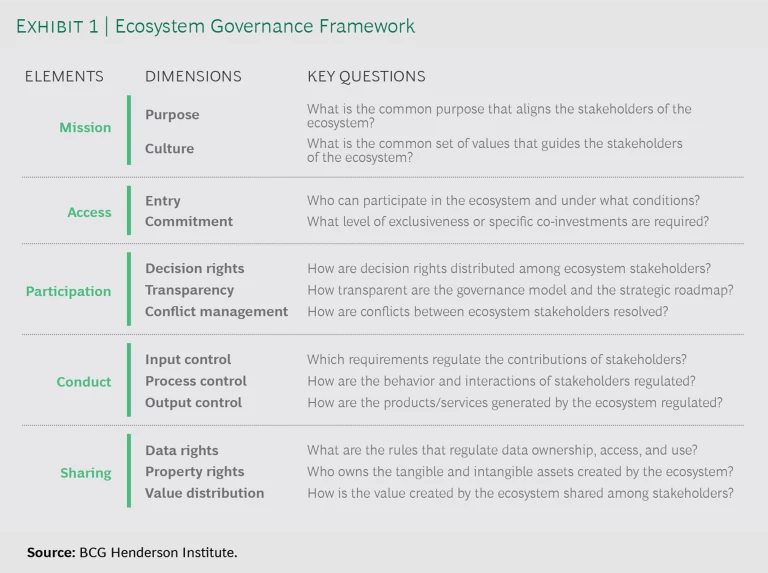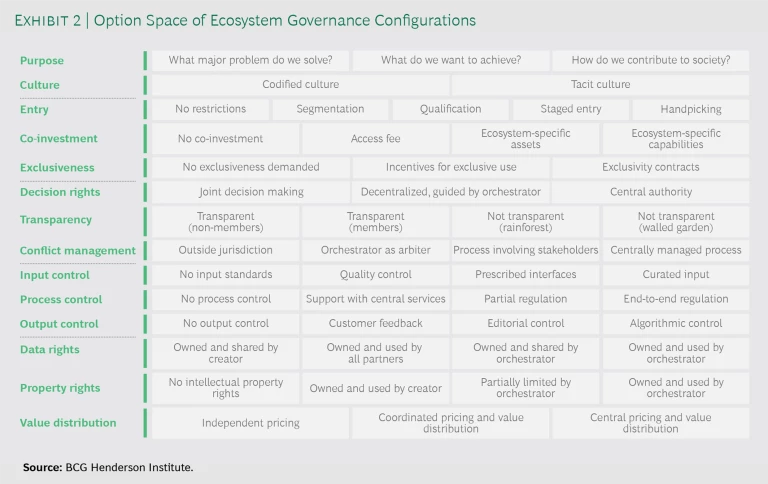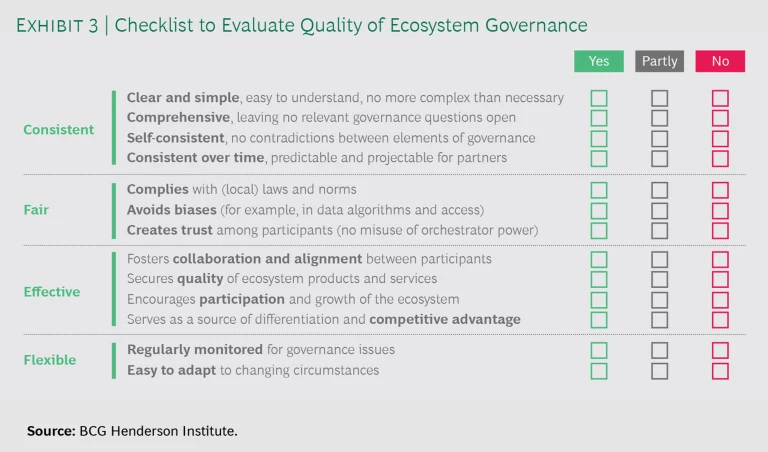This article is part of a series of publications offering practical guidance on business ecosystems. Other installments address more key questions: “Do You Need a Business Ecosystem?” “How Do You Design a Business Ecosystem?” “Why Do Most Business Ecosystems Fail?” “How Do You Succeed as a Business Ecosystem Contributor?”
It is widely acknowledged that business ecosystems offer great potential. Compared to more traditionally organized businesses, such as vertically integrated companies or hierarchical supply chains, business ecosystems are praised for their ability to foster innovation, scale quickly, and adapt to changing environments.
However, many companies that try to build their own ecosystems struggle to realize this potential. Our research has shown that less than 15% of business ecosystems are sustainable in the long run and that the most prevalent reason for failure is weakness in the governance model—the way the ecosystem is managed.
Governance Failures
Business ecosystems are prone to different types of governance failures. Many ecosystems struggle because they choose a governance model that is too open. For example, Shuddle launched in 2014 with the ambition to become the Uber for kids. The company offered relatively open access to its platform and did not subject its drivers to fingerprint background checks, in contrast to its more successful competitor HopSkipDrive, which was convinced that such checks are necessary if children are involved. As a result of its open governance model, Shuddle not only faced security concerns but also found it difficult to ensure the required service quality. It had to shut down in 2016.
Other ecosystems fail because of a governance model that is too closed. For example, when the iPhone launched in 2007, the BlackBerry was still widely considered a superior smartphone for corporate users—in terms of its data security, keypad, and battery life. RIM, the company behind the BlackBerry, understood that it needed to follow an ecosystem approach to the development of applications for its device. However, with the aim to maintain its high data security standards, the company chose a rather closed governance model, limiting the incentive for app developers to join the platform. As a consequence, the BlackBerry lost ground to the smartphone ecosystems based on iOS or Android and became a niche product.
Some business ecosystems struggle because they cannot control bad behavior on their platforms. For example, many restaurant booking platforms suffer from large numbers of “no show” reservations that alienate their restaurant partners. OpenTable addressed this challenge by requiring diners to cancel reservations they make through the platform at least thirty minutes in advance, banning users who fail to follow this policy four times within a twelve-month period.
Another type of governance failure involves conflicts among ecosystem partners—in particular, conflicts between the orchestrator and its complementors. Early warning signs include complaints from complementors about the orchestrator exploiting its dominant position and imposing unfair terms and conditions on the ecosystem. For example, Amazon was accused of using sales data from third-party merchants on its marketplace to identify attractive market segments and enter them with its own brands. Similarly, Epic Games, the developer of the popular online video game Fortnite, recently filed antitrust lawsuits against Apple and Google, accusing both companies of misusing their dominant positions in mobile operating systems by requiring that payments for in-app digital content be processed via their app stores’ respective internal billing systems.
Extreme cases of governance failure can result in legal action against platforms and their ecosystems.
Some business ecosystems experience backlash from consumers or regulators, indicating weaknesses in their existing governance that may threaten their license to operate. For example, social networks are harshly criticized for their data privacy policies and for disseminating false or misleading information on their platforms. Ride-hailing and lodging marketplaces are accused of circumventing regulation in the transportation and hospitality sector in order to avoid costly requirements for safety, insurance, hygiene, and workers’ rights.
Finally, an extreme case of governance failure results in legal actions against the platform or its ecosystem. For example, Backpage.com, a classified ad website, did not restrict the types of ads it would accept, leading to many solicitations for illegal activities. This led to at least eight lawsuits between 2011 and 2016. Backpage won each of these lawsuits, but the website was eventually seized as part of an investigation by federal law enforcement agencies.
Objectives and Challenges
Getting the governance of your ecosystem right is thus a major success factor and a big challenge. Orchestrators must establish an effective governance model, which we define as the set of explicit or implicit structures, rules, and practices that frame and govern the behavior and interplay of participants in a business ecosystem.
Many orchestrators struggle with this challenge because managing an ecosystem is very different than managing an integrated company or a vertical supply chain. Ecosystems are built on voluntary collaboration between independent entities, rather than on clearly defined customer-supplier relationships and transactional contracts. Instead of exerting hierarchical control, the orchestrator must convince partners to join and collaborate in the ecosystem. This challenge is magnified by the dynamic nature of the ecosystem model. Most business ecosystems develop very quickly. They continually add new products and services, connect new members, and change roles and interactions, posing very high requirements for flexibility and adaptability in the governance model.
In some ways, the governance of an ecosystem can be compared to the governance of a market economy. The role of the orchestrator is not to manage but to enable the other players and to act as the steward of the ecosystem. The governance model is needed to avoid market failures, and it must pursue three objectives:
- Support value creation of the ecosystem. The governance model must facilitate recruiting, motivating, and retaining partners; align partners’ interests, strategies, and actions; and optimize resource allocation across partners.
- Manage risk in the ecosystem. The governance model must ensure that all partners comply with laws and norms; protect the reputation of the ecosystem; ensure its social acceptance to avoid backlash from consumers, incumbents, or regulators; and minimize all other kinds of negative externalities.
- Optimize value distribution among ecosystem partners. The governance model needs to establish a fair way to share the value that is created by the ecosystem and ensure that all partners can earn a decent profit and are compensated in accordance with the value they add to the system.
A Framework for Ecosystem Governance
How can the orchestrator and partners of an ecosystem develop a governance model that best achieves the above objectives? Based on our analysis of the governance of more than 80 business ecosystems from various domains, we have developed a comprehensive framework of ecosystem governance. (See Exhibit 1.)
The framework covers the five main building blocks that must be used in managing a business ecosystem:
- Mission: What are the common purpose and culture that guide and align the stakeholders of the ecosystem?
- Access: Who is allowed to enter the ecosystem, and what level of commitment in terms of exclusiveness and/or specific co-investment is required?
- Participation: How are decision rights distributed among ecosystem stakeholders, how transparent are the governance model and strategic roadmap, and how are conflicts resolved?
- Conduct: How is the behavior of ecosystem stakeholders regulated by controlling the input they provide, the process they need to follow, and the output they generate?
- Sharing: What are the rules that regulate data rights and other property rights, and how is the value created by the ecosystem distributed among stakeholders?
To elucidate how the governance model of a business ecosystem can be systematically designed, we discuss the five building blocks of ecosystem governance in more detail, explain the choices for each dimension, and illustrate them with examples.
Mission. Partners in a business ecosystem can be aligned by a common mission that is expressed as a connecting sense of purpose or a joint set of values and culture.
Purpose can be a strong motivation for joining and contributing to an ecosystem. It typically relates to a major problem that can be solved through the ecosystem, a big goal that is to be achieved, or an important contribution to society. For example, Kiva, a nonprofit crowdfunding platform operating across 76 countries, aligns partners behind its purpose to “expand financial access to help underserved communities thrive.” The ecosystem wants to create a “financially inclusive world where all people hold the power to improve their lives” and contribute to society because “through Kiva's work, students can pay for tuition, women can start businesses, farmers are able to invest in equipment, and families can afford needed emergency care.”
A strong culture can also help align partners in an ecosystem. Sometimes the culture is codified in a defining set of values, as in Wikipedia’s five fundamental principles, which state that Wikipedia (1) is an encyclopedia (not an advertising platform), (2) is written from a neutral point of view, (3) is free content that anyone can use, edit, and distribute, (4) has editors who treat each other with respect and civility, and (5) has no firm rules.
In other ecosystems, culture is tacit but nonetheless strong, as in the case of Topcoder, a global talent network and crowdsourcing platform that connects more than a million designers, developers, data scientists, and testers with corporate clients. Topcoder rests on the coder communities' values of, for example, “intrinsic motivations for doing the work or learning from the work, career concerns, status and recognition in the community, or simple affiliation with the
Admittedly, some commercial business ecosystems lack a strong culture and are driven mainly by financial objectives. But if you can identify a compelling purpose for your ecosystem and establish a positive culture early in its development, you have a very potent instrument for attracting and retaining the right partners and encouraging the right behavior in your ecosystem without having to regulate every detail with complex rules and written standards.
Access. Controlling access can be an effective way to manage an ecosystem because it establishes not only who can participate in the ecosystem, and under what conditions, but also the level of commitment required in the form of exclusivity agreements and ecosystem-specific co-investments. Such access rules must be defined for the ecosystem’s partners and suppliers as well as its customers and users.
On the supply side, many ecosystems are very open and have no participation restrictions. Most online marketplaces are open to all sellers. Some platforms restrict entry by segmentation. The restaurant booking platform OpenTable, for example, recruited mainly restaurants from specific areas in selected cities as part of its launch
On the demand side, most ecosystems don’t limit participation. If restrictions exist, they are driven mainly by the scope of the product and service offering. For example, the B2B marketplace Covisint deliberately focused on the automotive industry. Similarly, car sharing platforms such as Getaround address only car drivers and require confirmation of a driver license for participation. Staged entry and freemium models are also common on the demand side, such as on the Amazon marketplace, where entry is free for all customers but premium services and offerings are available only for subscribers to Amazon Prime.
Asking for a certain level of ecosystem-specific co-investment can enhance commitment.
Another way to control access is to ask for a certain level of ecosystem-specific co-investment to enhance commitment to the ecosystem. As expected, this governance instrument is more common on the supply side. Some platforms simply try to achieve this commitment by demanding an access fee. For example, Google and Apple both charge app developers a one-time or annual fee to access their application programming interfaces (APIs). Some orchestrators require partners to invest in ecosystem-specific assets. For example, Apple initially demanded that its smart-home partners purchase Apple's MFi (Made for iPod/iPhone/iPad) chips and include them in their hardware. And other platforms encourage the development of ecosystem-specific capabilities. For example, SAP offers four partner levels. To move up, partners earn “value points” for contributions and investments. On the demand side, such co-investment requirements are less common and typically take the form of an access fee or the need to buy platform-specific equipment (for instance, a console for a video gaming platform).
Finally, orchestrators can link access to the ecosystem with incentives or requirements for exclusiveness, demanding that their partners not offer their products or services on competing platforms. While exclusiveness may be desirable, for most ecosystems it is not feasible. For example, most transaction ecosystems, such as marketplaces or booking and rental platforms, don’t demand exclusivity from either their suppliers or their users. Some platforms establish incentives for exclusive use, in the form of monetary rewards, additional services, or privileged information. For example, Amazon Fulfillment Services charges suppliers higher fees for orders not placed via the Amazon
Participation. Once partners are admitted to an ecosystem, the next governance question relates to the degree of their participation in the system’s development. Participation is reflected in the distribution of decision rights, transparency, and conflict management.
A small number of ecosystems opt for joint decision making and establish institutions and processes to share responsibility for governance and the strategic roadmap of the ecosystem. For example, the open-source operating system Linux is managed by a committee comprising members of the Linux community, including corporate members, individual open-source leaders, vendors, users, and distributors. Similarly, Wikipedia is governed by a structure of committees whose members are elected by the community and whose decisions are made by consensus.
At the other end of the spectrum, the orchestrators of most transaction ecosystems claim a central authority for deciding about the governance and strategic roadmap of the platform. For example, Uber and Airbnb both decide centrally which offerings to include on the platform, while ecosystem partners (drivers and lessors) are restricted to providing the service. Most solution ecosystems select an intermediate option with largely decentralized decision making that is guided by the orchestrator. For example, in many smart-home ecosystems, complementors decide independently about their offering and strategic roadmap, while the orchestrator defines the overall governance.
Participation requires transparency, and we observe a wide range of practices. Some ecosystems are largely transparent, even to nonmembers. For example, Dassault Systèmes (DS) shares a clear innovation roadmap for its product lifecycle management (PLM) ecosystem, laying out the target industries and planned solutions as well as the role DS wants to
The majority of ecosystems we investigated, however, are mostly not transparent. Such systems may follow a “rainforest” model, as do Google and Apple, which cannot provide much transparency about the future development of their mobile platforms owing to the independent, decentralized development of apps and the (deliberate) lack of a coordinated strategic roadmap. Or they may follow a “walled-garden” model, as do Uber and Airbnb, who don't want to disclose how they will develop their platforms, which verticals they are going to join, or which additional services partners are invited to offer in the future.
The final governance question related to participation is how conflicts between ecosystem stakeholders are resolved. Some ecosystems have no meaningful internal regulations for conflict management and rely on outside jurisdiction. Many emerging platforms have no defined processes and use the orchestrator as arbiter. For example, most social media platforms start with only limited guidelines for conflict resolution and must decide on a case-by-case basis which content to take down.
When clear resolution processes are in place, we observe two models. In some ecosystems, conflicts are centrally managed by the orchestrator, as is the case at Uber, where riders and drivers can complain about each other via the Uber app and the conflict is resolved by a dedicated, central team. In other ecosystems, stakeholders are more strongly involved in conflict resolution. For example, community platforms such as Craigslist and Reddit use volunteers and professional moderators to solve conflicts. Alibaba even established a “market judgement committee” for its Taobao platform to regulate product classification; members are selected from qualified buyers and sellers, and decisions are made by
Conduct. Most orchestrators don’t want to manage their ecosystems by relying only on a strong mission, access rules, and regulations for participation; they want to directly influence stakeholder behavior. They can choose from three approaches: input, process, and output control.
Input control specifies the requirements for the partners’ contributions to the ecosystem. Some ecosystems, such as most social platforms, have no input standards or only limited standards. For example, Twitter’s restriction of posts to a length of 280 characters is only a weak form of input control. Most digital solution ecosystems go one step further and control input through prescribed interfaces that specify input formats and technical interactions through APIs (application programming interfaces), SDKs (software development kits), and IDEs (integrated development environments).
Other ecosystems have established standards and instruments for quality control of new contributions. For example, Apple deploys extensive quality checks on newly developed apps before approving them for the platform. Taking yet another step, some orchestrators claim the right to handpick and curate input on their platform. New applications on John Deere’s smart-farming platform, for instance, must be individually approved and separately licensed. Initially, the online gaming platform Steam curated new games in its ecosystem, first by handpicking them centrally and then by letting users vote on which games to include (the “Steam Greenlight” process), but later it restricted itself to quality control by only reviewing game configurations and checking for malicious content (the “Steam Direct” process).
To directly influence stakeholder behavior, orchestrators employ input, process, and output control.
In process control, the orchestrator tries to regulate the behavior of partners as they interact with each other and with the platform. Again, many social platforms are examples of ecosystems with no process control or only limited control. For example, Craigslist provides only an open interface for communication and matching, while the process for the resulting transactions and their fulfillment is not regulated. At the other end of the spectrum, some ecosystems stipulate end-to-end process regulation. For example, Kiva centrally defines every step on its microfinance platform, from loan application to underwriting, approval, posting, fundraising, disbursal, and repayment. Uber even prescribes the routes that drivers should take.
Other ecosystems establish partial regulation of the process. Apple, for instance, uses the AppStore as a control point for the distribution and purchase of apps. And some orchestrators try to softly govern behavior on their platform by offering process support with central services. Software ecosystems such as SAP and AWS provide forums, services, and training to help partners develop new applications and improve the scope and quality of the offering.
Finally, the output control approach directly regulates the quality of products and services created by the ecosystem. Very few platforms deliberately apply no output control or only limited control. For example, Doctolib, an online booking platform that matches doctors with patients, explicitly refrains from evaluating doctors because objective measures are difficult to apply in health care. The most frequent mechanism for output control in transaction ecosystems is customer feedback. It can be used just for transparency, as with most app store ratings or customer reviews on marketplaces or booking platforms, but it can also be used to exclude partners with evaluations below a certain threshold, as in the cases of Airbnb and Uber.
A more active instrument for regulating output is editorial control. It can be accomplished by the orchestrator, as it is at Facebook and Twitter, which have substantial internal units for content curation, but it can also be performed by qualified users. For example, the online gaming platform Steam appoints users as curators, who review games and connect with developers on Curator Connect, and explorers, who look for fake games. Lastly, some platforms use AI-based algorithmic control to curate output. On the Topcoder platform, for instance, code submitted in competitive programming matches is automatically assessed by algorithms, and the results are used for rating and ranking developers.
Sharing. The final building block of ecosystem governance regulates data rights, property rights, and how the value that is created by the ecosystem is shared among partners.
The regulation of data rights needs to address the ownership, access, and use of data in the ecosystem. We observe four basic models:
- Data is owned and shared by the creator. The owner of the data shares it case by case, only with the orchestrator (as do complementors of the Apple HomeKit), or more broadly with other partners in the ecosystem (in Germany, for example, patients decide on an individual basis which parties they grant access to their electronic health records).
- Data is owned and used by all partners, as is the case with Tracr, an end-to-end blockchain-based diamond tracing platform. Although this model is still rare today, we expect it to become more popular with further advancement and spread of blockchain technology.
- Data is owned and shared by the orchestrator. Alibaba, for example, owns transaction data on its marketplaces but voluntarily shares information on demand patterns with its merchants, encouraging them to invest in advanced data analytics.
- Data is owned and used by the orchestrator. Some platform orchestrators, such as Uber and Lyft, own all of the transaction data generated on their platforms and do not share it with their partners.
The regulation of property rights over the intangible assets that are created by the ecosystem faces similar challenges. In rare cases, there are explicitly no intellectual property rights derived from ecosystem activity. For example, contributors to Wikipedia agree to waive all property rights and release their contribution under the Creative Commons Attribution-ShareAlike license. In most solution ecosystems, however, intellectual property is owned and used by the creator. For instance, developers and complementors in the Linux ecosystem own the intellectual property of their Linux versions (for example, RedHat) or solutions built with Linux. Occasionally, property rights are partially limited by the orchestrator, as is the case with SAP, which offers “timed” property rights for partner applications and provides an ecosystem roadmap for the next two years, laying out which existing products will be integrated into SAP’s core
When it comes to value distribution, many ecosystems follow a strict market-based approach and encourage independent pricing by ecosystem members. For example, on the Apple and Android mobile platforms, the orchestrator sets a take rate and developers are free to set prices for their applications. Topcoder has established an inverse market mechanism in which corporate clients set the price they are ready to pay and developers compete for the project. Some solution ecosystems try to optimize value capture for their platform by coordinating pricing and negotiating value distribution. Many video game console platforms, for instance, subsidize hardware with game sales. Climate FieldView sets package prices for its smart-farming offering and individually negotiates value distribution with its partners and suppliers. Finally, some ecosystems apply central pricing and value distribution, letting partners decide to accept or to leave. For example, ride-hailing platforms Uber and Lyft use central algorithmic pricing schemes, and content providers on media and entertainment platforms such as YouTube, Medium, and Spotify receive a share of value based on the engagement level of users.
How to Select the Right Governance Model
Given the many essential elements of ecosystem governance and the many options for each element (see Exhibit 2), how can you select the best governance model for your ecosystem?
For starters, there are some general characteristics of good ecosystem governance (see Exhibit 3):
- Consistency. The governance model should be clear and simple, no more complex than necessary, and easy to understand for all stakeholders. At the same time, it should comprehensively address all relevant governance questions. In addition, the individual elements of governance should be self-consistent, free of contradictions, and consistent over time to provide a predictable framework for all partners.
- Fairness. Good ecosystem governance ensures fair and trusted dealings with all stakeholders. In particular, it should be compliant with local laws and norms and avoid inappropriate biases in, for example, data algorithms and access. Overall, the governance model should create trust among partners and, in particular, inhibit the misuse of orchestrator power.
- Effectiveness. In order to be effective, the governance model should foster collaboration and alignment between participants, secure the quality of the ecosystem’s products and services, and encourage participation and growth of the ecosystem. In this way, effective governance can become a source of differentiation and competitive advantage for the ecosystem.
- Flexibility. Finally, ecosystem governance must be regularly monitored. Instruments and early-warning indicators for emerging governance issues should be in place, and the governance model should be flexible enough to adapt to changing circumstances and new challenges.
Besides these general characteristics of good ecosystem governance, ecosystem-specific criteria play a role in selecting the right governance model. For example, we find that many successful transaction ecosystems opt for a rather open access model with only limited requirements regarding the commitment of partners. Decision rights are owned mainly by the platform orchestrator, and data sharing is limited. Behavior on the platform is tightly regulated on the basis of standard terms and conditions and sophisticated instruments for input, process, and output control. In contrast, many successful solution ecosystems that we investigated are more selective in granting access to the ecosystem. They are more frequently aligned by a common purpose and set of values and require a higher level of commitment in the form of ecosystem-specific investments or capabilities. In exchange, solution ecosystems give partners more decision rights, share data more broadly, and curtail the behavior in the ecosystem less strictly.
More generally, the right governance model also depends on the strategic priorities of the ecosystem. If the focus is on fast growth, flexibility, decentralized innovation, exploration, and value creation, the governance model should be rather open and follow the rainforest paradigm of diversity, autonomous creativity, and adaptability, as exemplified by Alibaba’s Taobao marketplace and the Android mobile operating system. If, on the other hand, the focus is on quality, commitment, coordinated innovation, exploitation, and value capture, the governance model should be rather closed and follow the walled-garden paradigm of consistency, alignment, and control, as exemplified by the B2B platforms for smart farming and smart mining.
Ecosystem governance is not static; it must be actively developed over time.
Finally, it is important to acknowledge that ecosystem governance is not static; it must be actively developed over time. The initial governance model can be tailored to the early set of ecosystem partners, but the orchestrator must make sure that the model is scalable and doesn’t become too complex as the ecosystem grows. The development of an ecosystem is strongly path dependent, and many successful platforms start with a rather closed approach to establish the right quality and behavior but then scale up and open up as the ecosystem grows.
As digital platforms and business ecosystems become more widespread, they will increasingly compete on the basis of their governance. Companies that build their own platform and ecosystem can use the frameworks presented in this article to systematically think through the building blocks and options for ecosystem governance and find the right model for their ecosystem. Companies that consider joining an ecosystem as complementor or supplier can use the frameworks to analyze an ecosystem’s governance model and assess its consistency, fairness, effectiveness, flexibility, and ability to meet the company’s specific requirements.









